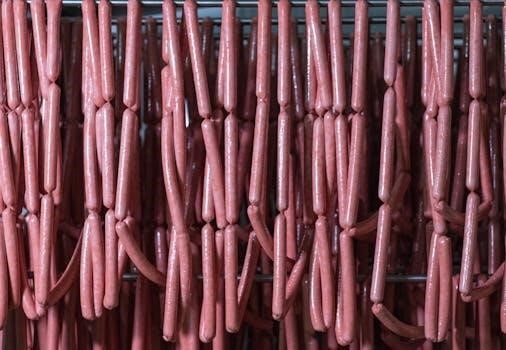
refrigeration process pdf
Refrigeration Cycle⁚ An Overview
The refrigeration cycle is a cornerstone of cooling technologies‚ found in air conditioners‚ refrigerators‚ and heat pumps. It operates using thermodynamic principles to transfer heat from a low-temperature source to a high-temperature sink‚ cooling the desired space.
Fundamentals of Refrigeration
Refrigeration is the process of removing heat from an enclosed space or substance and rejecting it elsewhere. This is achieved by circulating a refrigerant through a closed system where it undergoes phase changes. The basic principle relies on the evaporation of a liquid refrigerant‚ which absorbs heat from the surroundings‚ creating a cooling effect. The refrigerant is then compressed‚ raising its temperature and pressure‚ before being condensed to release the absorbed heat. Understanding these principles is crucial for analyzing refrigeration cycles and optimizing system performance.
Vapor Compression Refrigeration Cycle
The vapor-compression refrigeration cycle is a common method for transferring heat from a low-temperature to a high-temperature. It’s the ideal model for understanding refrigeration systems and their components.
Ideal Vapor-Compression Cycle
The ideal vapor-compression refrigeration cycle serves as a theoretical benchmark for assessing real-world refrigeration systems. Unlike the reversed Carnot cycle‚ this cycle ensures complete vaporization of the refrigerant before compression. A throttling device replaces the turbine‚ simplifying the process. The cycle is composed of four key processes⁚ isentropic compression‚ constant-pressure heat rejection in the condenser‚ throttling in the expansion valve‚ and constant-pressure heat absorption in the evaporator. This idealized model allows for a clearer understanding of the fundamental principles at play.
Real Refrigeration Cycle
The real refrigeration cycle deviates from the ideal due to irreversibilities present in actual components. These include friction‚ heat transfer‚ and pressure drops. Unlike the anticlockwise ideal cycle‚ processes of evaporation‚ condensation‚ expansion and compression swap places. The compression process is no longer isentropic‚ leading to increased entropy generation and reduced efficiency. The cycle shares similarities with the steam power cycle‚ with the major difference being its direction. Understanding these deviations is crucial for optimizing real-world refrigeration systems and improving their performance by minimizing energy losses.

Components of a Refrigeration System
Refrigeration systems consist of key components. These components are compressor‚ condenser‚ expansion valve‚ and evaporator. Each component plays a crucial role in the refrigeration cycle‚ facilitating heat transfer and phase change of the refrigerant.
Compressor
The compressor is the heart of the refrigeration system. It increases the pressure and temperature of the refrigerant vapor. The compressor receives low-pressure refrigerant vapor from the evaporator and compresses it into a high-pressure‚ high-temperature superheated vapor. This process adds energy to the refrigerant‚ preparing it for the next stage. The energy used to compress the gas is turned into sensible heat. The refrigerant then flows to the condenser.
Condenser
The condenser is a heat exchanger that rejects heat from the high-pressure refrigerant vapor. Hot‚ high-pressure refrigerant vapor enters the condenser and cools down‚ releasing heat to the surrounding environment (air or water). As the refrigerant loses heat‚ it changes phase from a vapor to a high-pressure liquid. This high-pressure liquid then flows towards the expansion valve. Condensers are designed to efficiently dissipate heat‚ enabling the refrigerant to transition into a liquid state.
Expansion Valve (Throttling Device)
The expansion valve‚ also known as a throttling device‚ plays a crucial role in the refrigeration cycle. It reduces the pressure of the liquid refrigerant coming from the condenser. This pressure drop causes a sudden decrease in temperature due to the Joule-Thomson effect. The refrigerant enters the evaporator as a low-pressure‚ low-temperature mixture of liquid and vapor. This process is isenthalpic‚ meaning it occurs at constant enthalpy‚ which is vital for effective cooling.
Evaporator
The evaporator is a heat exchanger where the low-pressure‚ low-temperature refrigerant absorbs heat from the surrounding environment. As the refrigerant absorbs heat‚ it changes its state from a liquid to a vapor. This phase change is what provides the cooling effect. A fan often assists in circulating air across the evaporator coils‚ maximizing heat transfer. The resulting low-pressure vapor then flows back to the compressor‚ completing the refrigeration cycle and starting the process anew.

Refrigeration Cycle Stages
The refrigeration cycle consists of four main stages⁚ compression‚ condensation‚ expansion‚ and evaporation. Each stage plays a crucial role in the continuous process of heat removal and temperature regulation within a refrigeration system.
Compression
In the compression stage‚ low-pressure refrigerant vapor enters the compressor‚ where its pressure and temperature are significantly increased. This process requires energy input‚ typically supplied by an electric motor. As the refrigerant is compressed‚ the energy used is converted into sensible heat‚ which is absorbed by the refrigerant‚ resulting in a high-temperature‚ high-pressure superheated vapor ready for the next stage in the cycle.
Condensation
Following compression‚ the high-pressure‚ high-temperature refrigerant vapor flows into the condenser. Here‚ the refrigerant releases heat to the surrounding environment‚ typically air or water‚ causing it to change phase from a vapor to a high-pressure liquid. This process releases latent heat‚ and the refrigerant exits the condenser as a saturated or subcooled liquid‚ ready to proceed to the expansion valve and continue the refrigeration cycle.
Expansion
The high-pressure liquid refrigerant then enters the expansion valve‚ also known as a throttling device. This component drastically reduces the refrigerant’s pressure. This sudden pressure drop causes a portion of the liquid refrigerant to flash into vapor‚ resulting in a significant temperature decrease. The resulting low-pressure‚ low-temperature mixture of liquid and vapor refrigerant is now ready to absorb heat in the evaporator‚ continuing the cycle.
Evaporation
In the evaporator‚ the cold‚ low-pressure refrigerant absorbs heat from the surrounding environment‚ cooling the air or space. As it absorbs heat‚ the refrigerant undergoes a phase change from a liquid to a low-pressure vapor. This process removes heat from the refrigerated space. The low-pressure vapor then travels back to the compressor to repeat the cycle‚ ensuring continuous cooling. The refrigeration effect is measured by the amount of heat removed.
Types of Refrigeration Cycles
Various refrigeration cycles exist‚ each tailored for specific applications. Common types include vapor absorption‚ air refrigeration (dense cycle)‚ and cascade cycles. These cycles differ in their operating principles and refrigerants used to achieve cooling.
Vapor Absorption Refrigeration
Vapor absorption refrigeration utilizes heat as its energy source‚ unlike the vapor compression cycle that uses mechanical work. This cycle employs an absorbent to absorb the refrigerant vapor‚ forming a solution. Heat is then applied to regenerate the refrigerant vapor‚ which is subsequently condensed and evaporated to produce the cooling effect. This method is especially useful where waste heat is readily available‚ offering a more energy-efficient alternative.
Air Refrigeration Cycle (Dense Cycle)
The air refrigeration cycle‚ also known as the dense cycle‚ uses air as the refrigerant. In this cycle‚ air is compressed‚ cooled‚ expanded‚ and then heated by the refrigerated space. Unlike other cycles‚ the refrigerant (air) remains in a gaseous state throughout the entire process‚ circulating within a closed system. This cycle is often used in aircraft air conditioning systems due to its simplicity and the availability of air.
Cascade Cycle
The cascade cycle is employed for achieving very low temperatures by utilizing multiple refrigeration cycles in series. Each cycle uses a different refrigerant optimized for its specific temperature range. The condenser of the higher-temperature cycle cools the evaporator of the lower-temperature cycle‚ effectively cascading the cooling effect. This method allows for efficient operation across a wider temperature range than a single-stage system‚ making it suitable for industrial applications.

Refrigerants
Refrigerants are the working fluids in refrigeration cycles‚ responsible for absorbing and releasing heat as they circulate through the system. They undergo phase changes from liquid to vapor and back‚ facilitating heat transfer. The choice of refrigerant depends on factors like temperature range‚ environmental impact‚ safety‚ and thermodynamic properties. Historically‚ refrigerants like CFCs and HCFCs have been phased out due to their ozone depletion potential‚ leading to the development of more environmentally friendly alternatives like HFCs‚ HFOs‚ and natural refrigerants.
Thermodynamic Principles of Refrigeration
Refrigeration relies on fundamental thermodynamic principles‚ primarily the laws of thermodynamics. These laws govern energy conservation and transfer‚ dictating how heat moves from colder to warmer environments with external work input‚ crucial for the refrigeration cycle.
Laws of Thermodynamics
The laws of thermodynamics are fundamental to understanding refrigeration. The first law dictates energy conservation; energy transforms‚ never created nor destroyed‚ vital for analyzing refrigeration cycle energy flows. The second law introduces entropy‚ stating heat spontaneously flows from hot to cold. Refrigeration requires work to reverse this‚ increasing entropy. These laws explain the necessity for external energy input in refrigeration systems.
Applications of Refrigeration
Refrigeration is essential across numerous sectors. In food preservation‚ it extends shelf life by slowing microbial growth. Air conditioning provides thermal comfort in buildings and vehicles; Industrial processes rely on refrigeration for manufacturing and chemical reactions. Medical applications include preserving biological samples and cooling equipment. Transportation utilizes refrigerated containers for perishable goods. Cryogenics‚ a specialized field‚ employs extreme refrigeration for scientific research and applications like MRI machines.

Coefficient of Performance (COP)
The Coefficient of Performance (COP) is a crucial metric for evaluating refrigeration system efficiency. It quantifies the ratio of desired cooling output to the required energy input‚ indicating how effectively a system transfers heat. A higher COP signifies greater efficiency‚ meaning more cooling is achieved with less energy consumption. COP values vary depending on the refrigeration cycle type‚ operating conditions‚ and refrigerant used. Analyzing COP is essential for optimizing system design and minimizing energy costs.
Safety Procedures for Non-HFC Refrigerants
The transition to non-HFC refrigerants necessitates strict adherence to safety procedures during maintenance and servicing. Non-HFC refrigerants often possess unique characteristics‚ such as flammability or toxicity‚ requiring specialized handling techniques. Service personnel must be thoroughly trained in these procedures‚ including proper ventilation‚ leak detection‚ and personal protective equipment usage. Furthermore‚ understanding refrigerant-specific safety data sheets (SDS) is essential for mitigating potential risks. Compliance with regulations and best practices ensures safe and responsible handling of these alternative refrigerants‚ protecting technicians and the environment.


Leave a Reply
You must be logged in to post a comment.